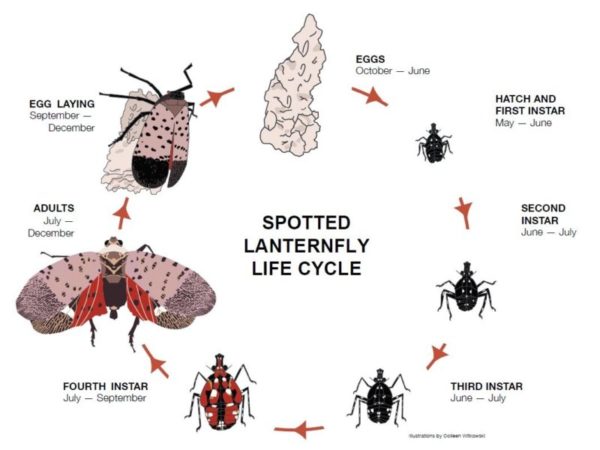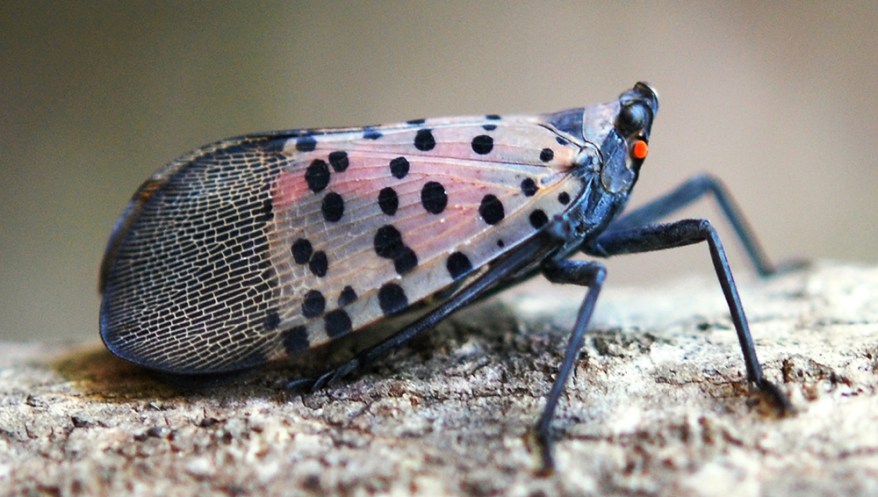In invasive species management, we try our very best to prevent the introduction of new invasive species. We conduct outreach events, develop prevention campaigns and programs, write news posts like this one and even talk about invasive species in our everyday lives. Somehow though, nature finds a way. While we greatly admire nature’s adaptability, it can make our job challenging.
The Department of Environmental Conservation and Department of Ag and Markets recently announced that the Spotted Lanternfly (SLF; Lycorma delicatula) has been found in Albany and Yates counties. SLF was only recently introduced to North America, having first been found in Pennsylvania in 2014 and quickly spreading to New Jersey, Delaware and Virginia.
SLF is unique in that it isn’t transported primarily on one medium like the emerald ash borer on firewood or hydrilla on boats, its egg masses can be laid and then transported on any outdoor item including firewood, stone, outdoor furniture and cars. To make this game of “I Spy” even more challenging, freshly laid egg masses of 30-50 eggs can look like brownish-gray spots of mud about one inch long.
Fortunately, the eggs are the only inconspicuous part the SLF. As immature nymphs in May, they are roughly the size of a pencil eraser and are black with white spots. As they grow, they develop a red body with black patches and white spots. Beginning in July, they transition into adults one inch long and develop gray wings with black spots and a bright red body under their wings.

Spotted Lanternfly Lifecycle. Photo Credit: Pennsylvania State Extension
What is so worrying about this pest is its destructive nature. The SLF uses its piercing-sucking mouth parts to feed on the sap of trunks, branches and twigs. This results in oozing wounds, characteristic of SLF infestations. As the SLF digests the sap, it excretes honeydew, a sticky fluid that builds up on the host plant. Honeydew attracts other insects and creates a welcoming environment for fungi. In total, these effects can cover leaf surfaces and stunt the growth of over 70 host plants including maples, apple trees, grapevines and hops. While damage cost estimates are not yet available for New York State, these crops make up the core of our agricultural and tourism industries, making estimates in the hundreds of millions likely.
While this invasive species could be extremely detrimental to New York State, the good news is that we were able to prepare. Organizations like the DEC, USDA, and WNY PRISM have been surveying for the SLF on its favorite, and also invasive, host plant, tree-of-heaven (Ailanthus altissima). Significant effort has also been put into educating the public, which is work that has paid off. Reports of new infestations usually occur once the invasive species is already established and made up of many individuals. However, private citizens were able to recognize this new threat and report it very early into the infestation; only 2 insects were found!
This is the perfect time of year to keep an eye out for SLF, which is now in the adult stage and is beginning to lay eggs. With new reports in New York, it’s even more important to be on the lookout for this invasive insect. If you think you have found either the insect itself or one of its egg masses, take pictures and report the infestation to iMapInvasives or to the DEC by emailing spottedlanternfly@dec.ny.gov.


